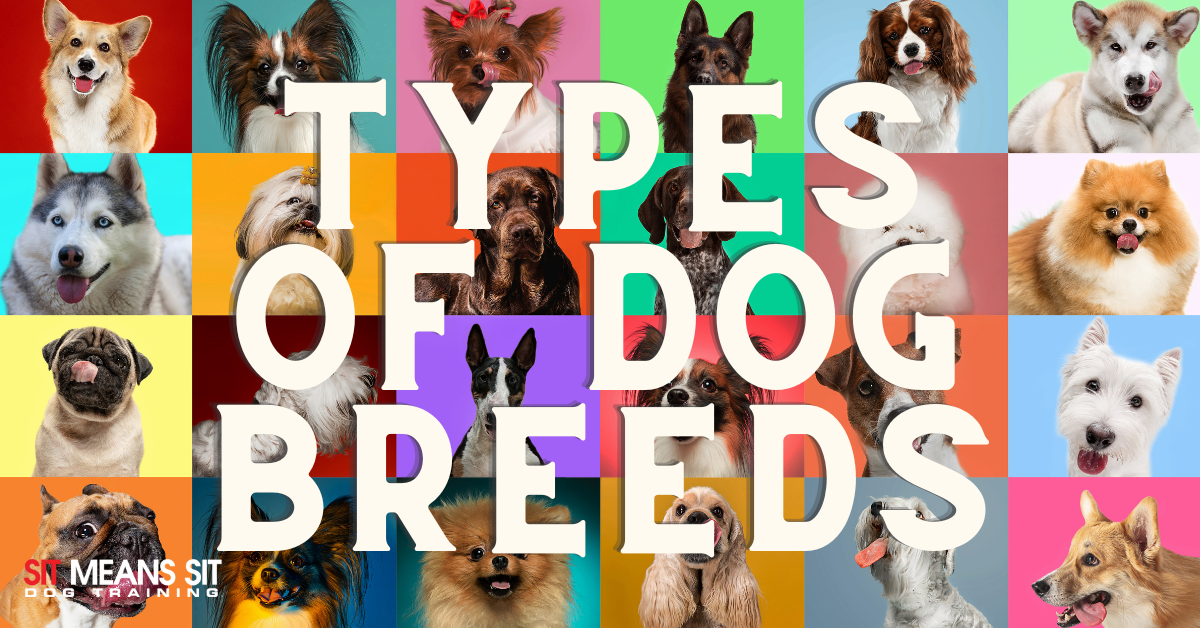
What are the Different Types of Dog Breeds?
While each breed, and even each individual dog, has their own characteristics and personality types, the American Kennel Club (AKC) has divided each specific dog breed into seven different types of breed.
The groupings are based on the different “jobs” or roles that the breed originally held, such as herding, sporting, hunting, or toy dogs.
Here are the seven different types of dog breeds and the characteristics of each
Sporting Group
Dogs in this group were originally bred to assist their owners with catching and retrieving feathered game, such as birds or ducks.
There are four different types of sporting dogs: spaniels, pointers, retrievers, and setters. Some breeds in this group specialize in swimming and are great for retrieving waterfowl while setters, spaniels, and pointing breeds are better for hunting in grasslands.
Each of the four different types of known for performing different tasks to aid the hunter. Pointers and setters mark game by “pointing” at them. They do this by posing nice and still with one front paw raised and their snout pointing in the direction of the animal being hunted. Spaniel breeds usually flush game, which means they scare the birds into taking flight so the hunter can fire at them in the air.
Hunting dogs aid their owners in many different ways during a hunting trip. Here are some essentials for hunting dogs to look at before your next hunting expedition.
Sporting breeds are characterized by their active and alert personalities, good temperaments, as well as their hunting instincts. They make great pets for active families who spend lots of time outside.
Hound Group
While hounds have similar hunting abilities to the sporting group, hounds have a more diverse group of breeds that rely heavily on their scent to track game. Breeds in this category include bloodhounds, beagles, and Basset hounds.
These dogs are generally extremely charming and affectionate as well as loyal companions. This makes them wonderful family pets, although they will require more vigorous exercise because of their high level of intelligence.
They possess strong prey drivers and can be stubborn once they have their mind set on something, often leading them to wander away from home while following a scent.
Toy Group
The top characteristic of the toy group is the stature of these canines. These dogs are often very small and don’t get very big at all.
Their existence since they were bred was for the purpose of serving as family companions. They are easily portable and can often be seen being carried in purses or arms. They are also and are often seen sitting on their owner’s laps earning them the nickname “lap dog.”
This group is generally classified as affectionate and easily adaptable to the family environment. They are intelligent, sociable, and full of energy. They can have big personalities, be high-strung, and try to be protectors of the home.
Working Group
The working group is defined as dogs who have jobs other than sporting. Their jobs are usually regarding guarding property or performing rescues. They have historically been tasked with jobs like pulling sleds and carts or guarding flocks.
These dogs are powerful, strong, and highly intelligent. They are often now seen working as police dogs, military dogs, and service dogs. They are extremely loyal and have a lot of energy.
These dogs make great family dogs but due to their high energy and big size, it is important to train and socialize them properly and make sure they have plenty of space to run.
Herding Group
Herding dogs are the most straightforward group of dogs. Their job has historically been and still is, to herd. They are tasked with gathering, herding, and protecting livestock. This could include sheep, cattle, and goats.
They take commands from their humans, either verbally or through hand signals, but their natural instinct will often tell them to work without being told.
They are highly trainable dogs, very affectionate, and extremely loyal. They thrive in homes with lots of structure and exercise. They need lots of mental and physical stimulation in order to prevent them from trying to herd your family members.
Terrier Group
The history of the terrier group has been to guard family homes or barns and to kill varmin like rats or badgers.
Terriers have different abilities based on breed to either pursue rodents underground or dig them out. They are courageous dogs with lots of confidence, have strong personalities, and can be prone to barking.
They need proper training as they can be inclined to be more destructive when left alone without something to do.
Non-Sporting Group
This group of dogs exists because they don’t fit anywhere else. Since there is such a wide variety of dogs in this category, it can be hard to characterize them since they are all of different sizes, functions, and histories.
The non-sporting group dogs tend to be good house dogs and watchdogs, but individual functions are determined by breed.
Dogs always fall into one of these seven categories, but family pets can come from any group of dog breeds. It’s all about what dog is the best fit for your household!
